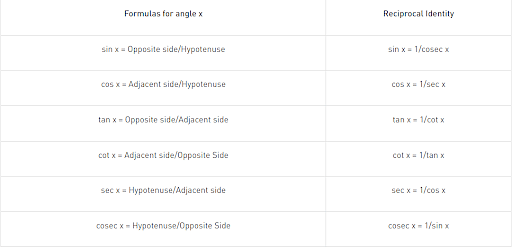In a triangle $ PQR, A, B $ and $ C $ are the angles opposite to the corresponding sides of lengths $ a, b $ and $ c $ respectively. If the sides are $ a = 5 $ , $ b = 13 $ and $ c = 12 $ then
$ sin \frac{B}{2} + cos \frac{B}{2} = $
- $ \frac{1}{2} $
- $ \frac{1}{\sqrt{2}} $
\(\sqrt{2}\)
- $ 1 $
The Correct Option is C
Solution and Explanation
The correct option is(C): \(\sqrt{2}\).

We have, \(a=5, b=13, c=12\)
Here, \(a^{2}+c^{2}=5^{2}+12^{2}\)
\(=169=13^{2}=b^{2}\)
\(\therefore \Delta\, PQR\) is right triangle right angled at \(Q\)
\(\therefore B=90^{\circ}\)
Now, sin \(\frac{B}{2}+cos \frac{B}{2}\)
\(=sin\, 45^{\circ} +cos\, 45^{\circ}\)
\(=\frac{1}{\sqrt{2}}+\frac{1}{\sqrt{2}}\)
\(=\sqrt{2}\)
Top Questions on Trigonometric Functions
- If, \(x∈(0,π)\) satisfies the equation \(6^{1+sinx+sin^2x....}=36\) ,then the value of \(x\) is_____.
- KEAM - 2023
- Mathematics
- Trigonometric Functions
- The value of a(≠0) for which the equation \(\frac{1}{2}(x-2)^2+1=\sin(\frac{a}{x})\) holds is/are
- KEAM - 2023
- Mathematics
- Trigonometric Functions
- Let P(x)=cos2x+sin4x,for any x∈R.Then which of the following options is correct for all x?
- KEAM - 2023
- Mathematics
- Trigonometric Functions
- Minimum value of 5cos(2x) + 5sin(2x)
- BITSAT - 2023
- Mathematics
- Trigonometric Functions
- If $\tan 15^{\circ}+\frac{1}{\tan 75^{\circ}}+\frac{1}{\tan 105^{\circ}}+\tan 195^{\circ}=2 a$, then the value of $\left(a+\frac{1}{a}\right)$ is :
- JEE Main - 2023
- Mathematics
- Trigonometric Functions
Questions Asked in JKCET exam
- A moving block having mass $m$, collides with another stationary block having mass $4\,m$. The lighter block comes to rest after collision. When the initial velocity of the lighter block is $v$, then the value of coefficient of restitution (e) will be
- JKCET - 2019
- work, energy and power
- A force $ F = 3x^2 + 2x + 1 $ acts on a body in the $ x $ -direction. The work done by this force during a displacement from $ x = -1 $ to $ +1 $ is
- JKCET - 2019
- work, energy and power
- What is the colour of the flame on heating potassium in the flame of a Bunsen burner?
- JKCET - 2019
- GROUP 1 ELEMENTS
- If $ a $ , $ b $ , $ c $ are the lengths of three edges of unit cell, $ \alpha $ is the angle between side $ b $ and $ c $ , $ \beta $ is the angle between side $ a $ and $ c $ and $ \gamma $ is the angle between side $ a $ and $ b $ , what is the Bravais Lattice dimensions of a tetragonal crystal?
- JKCET - 2019
- The solid state
- Which of the following compounds is known as copper glance?
- JKCET - 2019
- General Principles and Processes of Isolation of Elements
Concepts Used:
Trigonometric Functions
The relationship between the sides and angles of a right-angle triangle is described by trigonometry functions, sometimes known as circular functions. These trigonometric functions derive the relationship between the angles and sides of a triangle. In trigonometry, there are three primary functions of sine (sin), cosine (cos), tangent (tan). The other three main functions can be derived from the primary functions as cotangent (cot), secant (sec), and cosecant (cosec).
Six Basic Trigonometric Functions:
- Sine Function: The ratio between the length of the opposite side of the triangle to the length of the hypotenuse of the triangle.
sin x = a/h
- Cosine Function: The ratio between the length of the adjacent side of the triangle to the length of the hypotenuse of the triangle.
cos x = b/h
- Tangent Function: The ratio between the length of the opposite side of the triangle to the adjacent side length.
tan x = a/b
Tan x can also be represented as sin x/cos x
- Secant Function: The reciprocal of the cosine function.
sec x = 1/cosx = h/b
- Cosecant Function: The reciprocal of the sine function.
cosec x = 1/sinx = h/a
- Cotangent Function: The reciprocal of the tangent function.
cot x = 1/tan x = b/a
Formulas of Trigonometric Functions:




